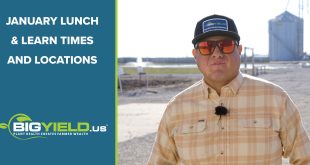At this time of year, weed and insect pressure require watchful management. If either pressure runs rampant, then plant health and yields are bound to suffer.
Weeds compete with crops for water and nutrition. This competition can weaken the opportunity for crops to leverage these resources for their own benefit. From a pest perspective, insects can attack corn ears, soybean pods or crops themselves. All can have a damaging effect on plant health and yields.
In-crop burning serves as a chemical-free management option for controlling weeds and pests. Burners use a propane torch to create heat that can top 2,000 degrees. Temperatures that high can be deadly for weeds as they vaporize water from plant cells and cause the weeds to die. Additionally, the heat can sterilize the weed seed before it has a chance to germinate. Burners may kills weed seed within the top quarter-inch of soil.
From an insect control vantage point, heat from an in-crop burner can target insects and their eggs. This story from DTN/The Progressive Farmer highlights the importance of managing pests in a year like this one, characterized by a mild winter and other conditions well-suited for supporting harmful bugs.
With in-crop burning, a burner flame should be directed to the growth portion — generally, the top — of the weed. Avoid targeting the growth portion of the crop being grown. Thus, the ideal scenario for in-crop burning goes something like this. Wait to take a burner’s pass through the field until the growth portion of the crop is taller than the growth portion of the weed. At that time, the burner flame can be directed beneath the crop canopy and effectively kill weeds within and between rows.
Of note, heat from an in-crop burner can have detrimental effects on soybean blossoms. If the burner reaches a plant’s blooms, then the heat can smoke them, which results in those blooms not further developing into bean-bearing pods.
At The Farm Research Center in Garden City, Mo., we run our in-crop burning equipment at 5 mph. Per acre, we tend to use 4 gallons to 7 gallons of propane. Relative to the price of traditional spraying equipment and the spray itself, burning offers a cost-effective alternative.
For a summary of the top five things to know about using an in-crop burner, watch this video featuring Kent Kauffman of BigYield.us.
If you’re interested in in-crop burning on your operation, then please call or email anytime!
 BigYield High Yield Soybeans, High Yield Corn, and High Yield Wheat
BigYield High Yield Soybeans, High Yield Corn, and High Yield Wheat




Dear Big Yield,
I am writing from Vietnam Dairy Products Joint Stock Company (Vinamilk), the largest dairy company in Vietnam. Until now, we have twelve dairy cow farms along Vietnam and one in Laos with total area is more than 6000 hectares, one of them is organic farm. We grow corn, grass,… to supply the feed for cows.
We knew about Big Yield product by a video on youtube. We are impressed by Buner of Big Yield to control the weed in the corn field. Could you please send us the catalogue of Burners that can help us understand more about your products. We also would like to have a quotation for 3 Buners with 5 torchs. (CIF price to Cat Lai Port, Ho Chi Minh City).
If you need to clarify anything please contact me by email: pxqphong@vinamilk.com.vn
Looking forward hearing from you soon.
Thank you & Best regards,